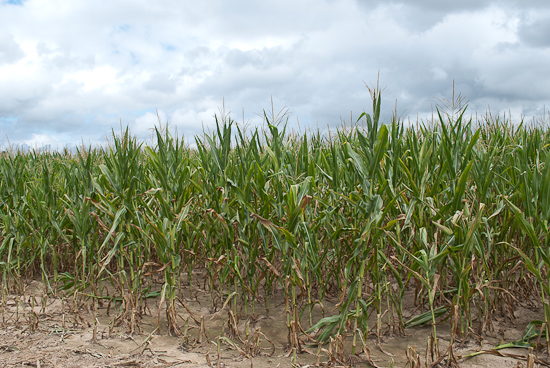Insurance, ACRE payments on drought-stressed crops will vary
Insurance, ACRE payments on drought-stressed crops will vary

Published on July 25, 2012
With much of the state’s corn crop prospects deteriorated, producers have been contacting their crop insurance agents, examining their insurance policies and wondering how they might be compensated.
“It is very likely that between 88 and 92 percent of the state’s corn acreage was insured,” said Cory Walters, University of Kentucky College of Agriculture economist.
Producers who suspect they have a yield loss should contact their crop insurance agents for further instruction on their crop.
Due to the condition of the crop, many producers will likely receive some type of crop insurance payment. Payments will vary, depending on a producer’s coverage level, insurance type and unit type. By examining the schedule of insurance in their policies, producers can review their insurance decisions. Due to the various decisions associated with a Multiple Peril Crop Insurance policy, Walters estimated that crop insurance premiums cost Kentucky producers somewhere between $7 and $20 per acre.
“Higher coverage levels imply a higher bushel guarantee and therefore a higher possibility of payments,” Walters said. “Higher coverage levels have higher insurance premiums.”
Revenue protection insurance is the most common type of insurance policy. Each policy will have a revenue guarantee. Guarantees vary among producers depending upon the percentage of the crop they insured, their actual production history and whether they elected to use the harvest price or the projected harvest price to calculate a potential payment. Payments are triggered when a producer’s yield multiplied by the national price is less than their revenue guarantee.
Producers enrolled in the U.S. Department of Agriculture’s risk protection program, Average Crop Revenue Election, could also receive payments this year. For this to occur, Kentucky corn crop revenues must be less than the state’s ACRE revenue guarantee. The state revenue guarantee is calculated by multiplying the average U.S. cash prices for a commodity for the past two years by the state average yields for the past five years, exempting the highest and lowest yielding years. The USDA Farm Service Agency estimated the Kentucky preliminary ACRE revenue guarantee to be $573. Annual state revenue is calculated by multiplying the state yield by the ACRE national average market price. Yields and market price for this year are still unknown.
Once the state qualifies for ACRE payments, individuals must show their farm-level revenue is less than the ACRE benchmark for farms. This benchmark is calculated by multiplying the farm’s five-year average crop yields, subtracting the highest and lowest yielding years by the two-year ACRE program price plus crop insurance premiums.
For more information and calculations on yield requirements for possible payments and payment projections, see the UK extension publications, “Investigating Your Crop Insurance Policy in Front of a Drought” and “2012 Kentucky Corn and Soybean ACRE Payment Prospects”. Both are available online at http://www.ca.uky.edu/agecon/index.php?p=110. The Kentucky Drought Resources Web page has additional information for producers. It is available at http://drought.ca.uky.edu.
Agricultural Economics Extension Weather

